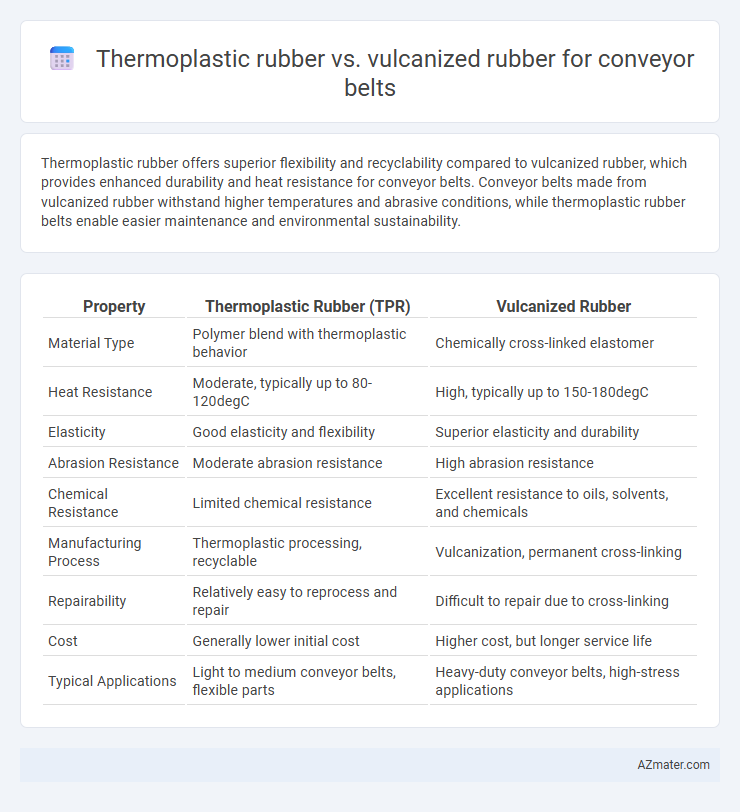Thermoplastic rubber offers superior flexibility and recyclability compared to vulcanized rubber, which provides enhanced durability and heat resistance for conveyor belts. Conveyor belts made from vulcanized rubber withstand higher temperatures and abrasive conditions, while thermoplastic rubber belts enable easier maintenance and environmental sustainability.
Table of Comparison
| Property | Thermoplastic Rubber (TPR) | Vulcanized Rubber |
|---|---|---|
| Material Type | Polymer blend with thermoplastic behavior | Chemically cross-linked elastomer |
| Heat Resistance | Moderate, typically up to 80-120degC | High, typically up to 150-180degC |
| Elasticity | Good elasticity and flexibility | Superior elasticity and durability |
| Abrasion Resistance | Moderate abrasion resistance | High abrasion resistance |
| Chemical Resistance | Limited chemical resistance | Excellent resistance to oils, solvents, and chemicals |
| Manufacturing Process | Thermoplastic processing, recyclable | Vulcanization, permanent cross-linking |
| Repairability | Relatively easy to reprocess and repair | Difficult to repair due to cross-linking |
| Cost | Generally lower initial cost | Higher cost, but longer service life |
| Typical Applications | Light to medium conveyor belts, flexible parts | Heavy-duty conveyor belts, high-stress applications |
Introduction to Conveyor Belt Materials
Conveyor belts utilize materials like thermoplastic rubber and vulcanized rubber, each offering distinct properties tailored to specific industrial applications. Thermoplastic rubber provides excellent flexibility and ease of processing, making it suitable for dynamic conveyor systems requiring frequent adjustments. Vulcanized rubber, known for its enhanced durability and resistance to wear and heat, is ideal for heavy-duty conveyor belts operating in harsh environments.
What is Thermoplastic Rubber?
Thermoplastic rubber (TPR) is a versatile material used in conveyor belts, characterized by its ability to be melted and reshaped multiple times without losing its elastic properties. Unlike vulcanized rubber, which undergoes a chemical curing process to form cross-linked bonds, TPR combines the elastic qualities of rubber with the processing advantages of thermoplastics. This makes TPR conveyor belts easier to manufacture, recycle, and repair, offering cost-effective and sustainable solutions in various industrial applications.
Understanding Vulcanized Rubber
Vulcanized rubber for conveyor belts undergoes a chemical process that enhances its durability, elasticity, and resistance to abrasion and heat, making it ideal for heavy-duty industrial applications. This cross-linking of polymer chains improves tensile strength and resistance to deformation compared to thermoplastic rubber, which relies on physical melting and reshaping properties. Understanding vulcanized rubber's superior mechanical and thermal performance is crucial for selecting conveyor belts designed for long-term, high-stress environments.
Key Properties of Thermoplastic Rubber
Thermoplastic rubber (TPR) for conveyor belts offers excellent flexibility, superior abrasion resistance, and easy processability through melting and reshaping, making it highly adaptable for various industrial applications. It maintains high elasticity and impact strength across a broad temperature range, ensuring durability and consistent performance under dynamic loading conditions. Compared to vulcanized rubber, TPR provides enhanced recyclability and lower production costs due to its thermoplastic nature without compromising tensile strength or chemical resistance.
Key Properties of Vulcanized Rubber
Vulcanized rubber for conveyor belts exhibits superior tensile strength, enhanced abrasion resistance, and improved flexibility compared to thermoplastic rubber, ensuring durability under heavy loads and harsh conditions. Its chemically cross-linked structure provides excellent heat and chemical resistance, which extends belt life and minimizes maintenance costs. These key properties make vulcanized rubber an optimal choice for industrial conveyor belts requiring long-term performance and reliability.
Durability Comparison: Thermoplastic vs Vulcanized Rubber
Thermoplastic rubber conveyor belts offer high resistance to abrasion, impact, and chemical exposure, providing excellent durability in dynamic environments with frequent start-stop operations. Vulcanized rubber belts exhibit superior tensile strength, enhanced resistance to heat and aging, making them ideal for heavy-duty applications requiring long-term reliability and consistent performance. The choice depends on operational demands: thermoplastic rubber excels in flexibility and maintenance ease, while vulcanized rubber outperforms in sustained durability under harsh conditions.
Flexibility and Performance in Industrial Applications
Thermoplastic rubber offers superior flexibility and easy processability, allowing conveyor belts to withstand dynamic bending and repeated flexing without cracking. Vulcanized rubber provides enhanced durability, abrasion resistance, and higher tensile strength, making it ideal for heavy-duty industrial conveyor belts exposed to extreme stress and harsh environments. Industrial applications requiring a balance of flexibility for mechanical movement and robust performance for longevity often select materials based on specific operational demands, with thermoplastic rubber favored for light to medium loads and vulcanized rubber preferred for heavy-load, high-wear scenarios.
Cost and Maintenance Differences
Thermoplastic rubber conveyor belts typically offer lower initial costs due to their easier manufacturing and flexibility in design, while vulcanized rubber belts involve higher upfront expenses because of the complex vulcanization process that enhances durability. Maintenance for thermoplastic rubber belts is generally less intensive, benefiting from their resistance to wear and easier repairability, whereas vulcanized rubber belts demand more frequent and specialized maintenance to address cracking and degradation over time. The choice between the two materials hinges on balancing upfront investment against long-term maintenance costs aligned with operational demands.
Environmental Impact and Recycling
Thermoplastic rubber conveyor belts offer significant environmental advantages due to their recyclability, as they can be melted and reshaped multiple times without significant degradation, reducing waste and resource consumption. Vulcanized rubber belts, however, pose recycling challenges because the sulfur cross-links formed during vulcanization make the material thermoset and non-meltable, leading to difficulties in reclaiming and reprocessing, often resulting in landfill disposal or incineration. The environmental impact of vulcanized rubber is thus higher due to its limited recyclability and longer degradation times, stressing the importance of thermoplastic alternatives for sustainable conveyor belt applications.
Choosing the Right Rubber for Conveyor Belts
Thermoplastic rubber offers superior flexibility and ease of recycling, making it ideal for conveyor belts requiring frequent maintenance and environmental sustainability. Vulcanized rubber provides enhanced durability, high resistance to abrasion, and excellent heat and chemical stability, suited for heavy-duty conveyor belts in industrial applications. Selecting the right rubber depends on conveyor belt operational demands, with thermoplastic rubber preferred for light to medium loads and vulcanized rubber for high-stress, abrasive environments.

Infographic: Thermoplastic rubber vs Vulcanized rubber for Conveyor belt
 azmater.com
azmater.com